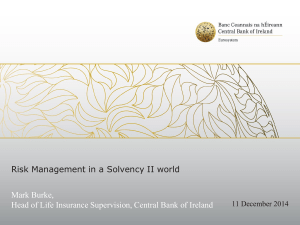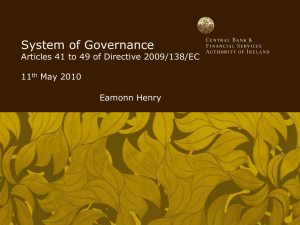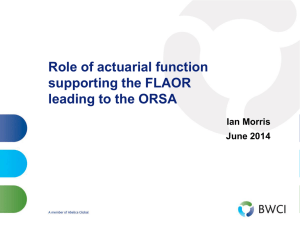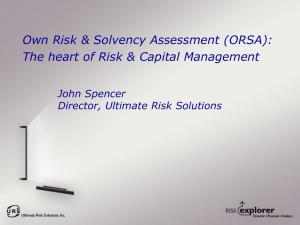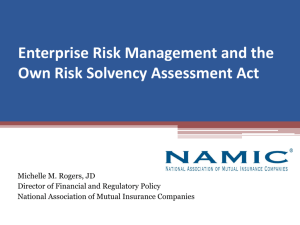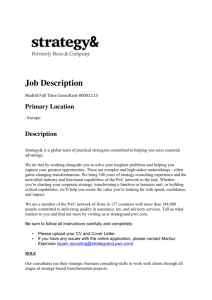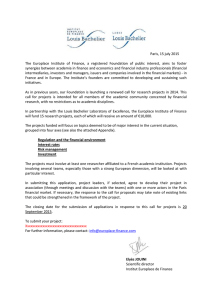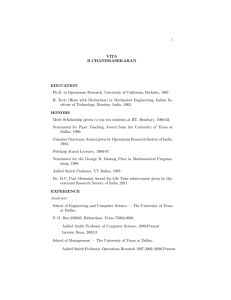Solvency II: Own Risk & Solvency Assessment
advertisement
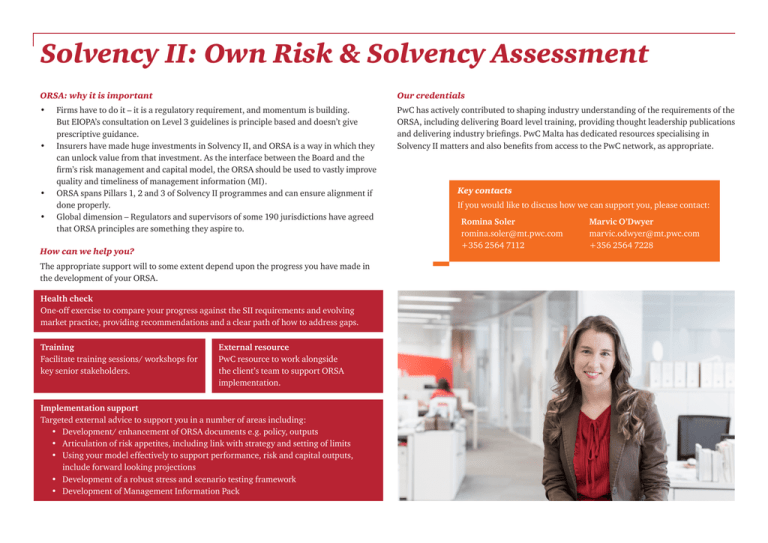
Solvency II: Own Risk & Solvency Assessment ORSA: why it is important Our credentials • PwC has actively contributed to shaping industry understanding of the requirements of the ORSA, including delivering Board level training, providing thought leadership publications and delivering industry briefings. PwC Malta has dedicated resources specialising in Solvency II matters and also benefits from access to the PwC network, as appropriate. • • • Firms have to do it – it is a regulatory requirement, and momentum is building. But EIOPA’s consultation on Level 3 guidelines is principle based and doesn’t give prescriptive guidance. Insurers have made huge investments in Solvency II, and ORSA is a way in which they can unlock value from that investment. As the interface between the Board and the firm’s risk management and capital model, the ORSA should be used to vastly improve quality and timeliness of management information (MI). ORSA spans Pillars 1, 2 and 3 of Solvency II programmes and can ensure alignment if done properly. Global dimension – Regulators and supervisors of some 190 jurisdictions have agreed that ORSA principles are something they aspire to. How can we help you? The appropriate support will to some extent depend upon the progress you have made in the development of your ORSA. Health check One-off exercise to compare your progress against the SII requirements and evolving market practice, providing recommendations and a clear path of how to address gaps. Training Facilitate training sessions/ workshops for key senior stakeholders. External resource PwC resource to work alongside the client’s team to support ORSA implementation. Implementation support Targeted external advice to support you in a number of areas including: • Development/ enhancement of ORSA documents e.g. policy, outputs • Articulation of risk appetites, including link with strategy and setting of limits • Using your model effectively to support performance, risk and capital outputs, include forward looking projections • Development of a robust stress and scenario testing framework • Development of Management Information Pack Key contacts If you would like to discuss how we can support you, please contact: Romina Soler romina.soler@mt.pwc.com +356 2564 7112 Marvic O’Dwyer marvic.odwyer@mt.pwc.com +356 2564 7228 Solvency II: Own Risk & Solvency Assessment The purpose of the ORSA process is to enable management to: • understand and manage the company’s risks (and associated controls) and capital against appetite; and • make informed strategic decisions that impact the firm’s risk profile. PwC’s view of the ORSA External Stakeholders It is a bespoke process for management to: • refine business planning and strategy; • define its capital needs; • continuously monitor regulatory capital; and • have a joined up view of risk profile, risk tolerance limits and business strategy. The Board Business strategy (medium term) Business planning (short term) It is a process not just a report. ion cis De nt me De na Ma s ion Risk profile post controls Our budget (short term, usually 1 year) - targeted return Our business planning (medium term, e.g. 3 years) cis ge nt me • Risk profile vs. apetite/tolerance • Expected return vs. target MI ge Risk Reward Profile What kind of company we are, what businesses we do and why (long term) na MI Ma s Example of Board decisions The ORSA moves Solvency II from compliance burden into business benefit What early warning signs exist re profit shortfall (you could call these KRIs)? Capital • Economic (overall solvency needs) • Regulatory What is our available capital - economic / SCR / MCR? What tolerance is there around targeted return - at various levels of granularity (you could call this risk appetite) / how unpalatable are various levels of profit shortfall (you could call this risk tolerance?) How do we manage the risk of profit shortfall (you could call these constraints)?
